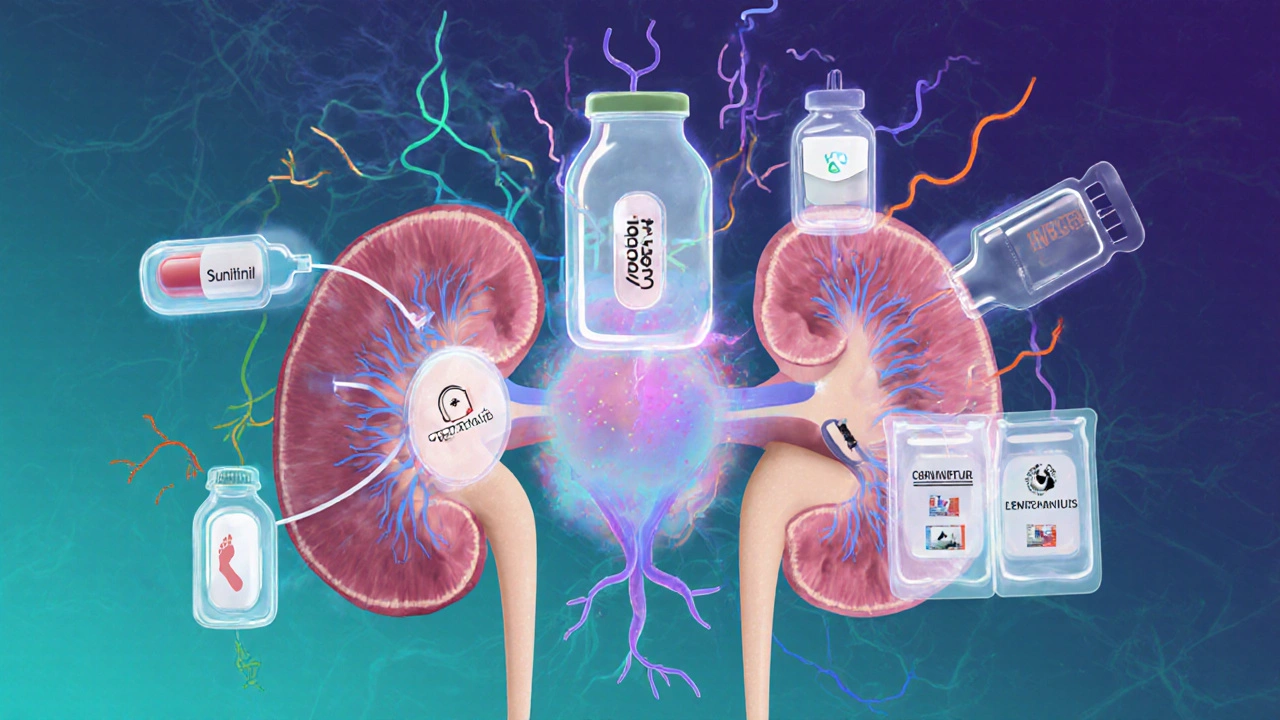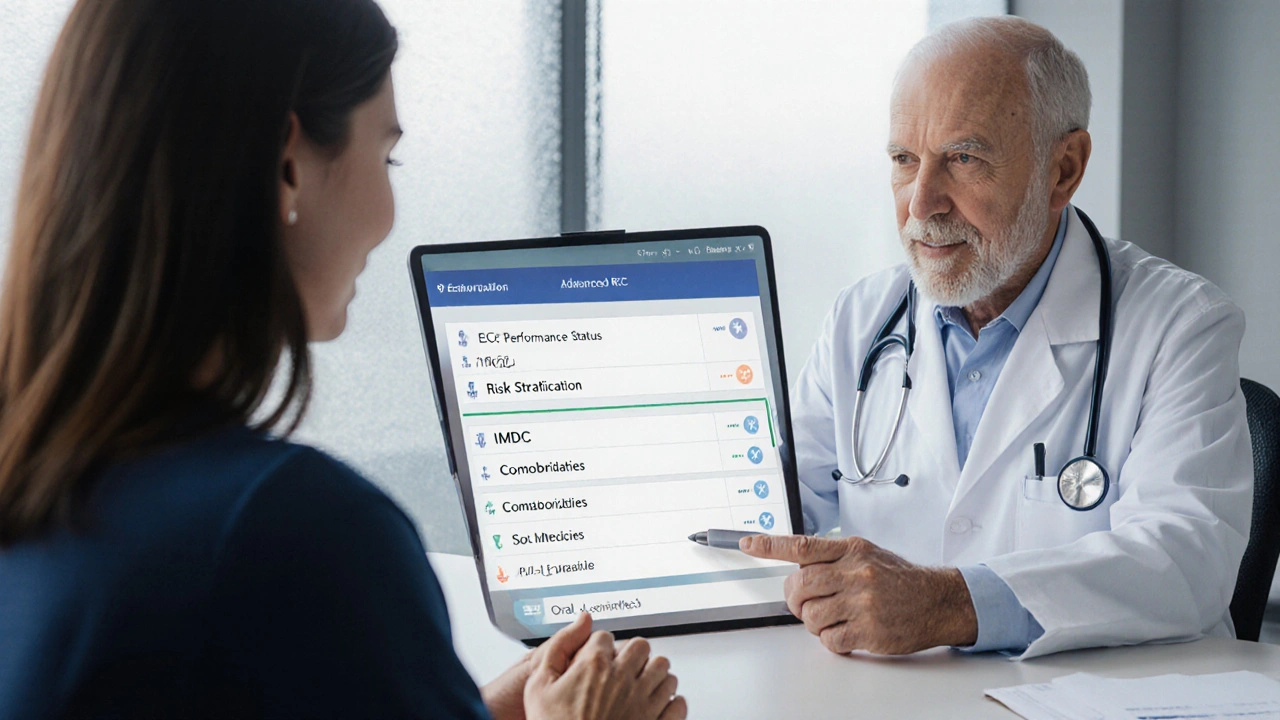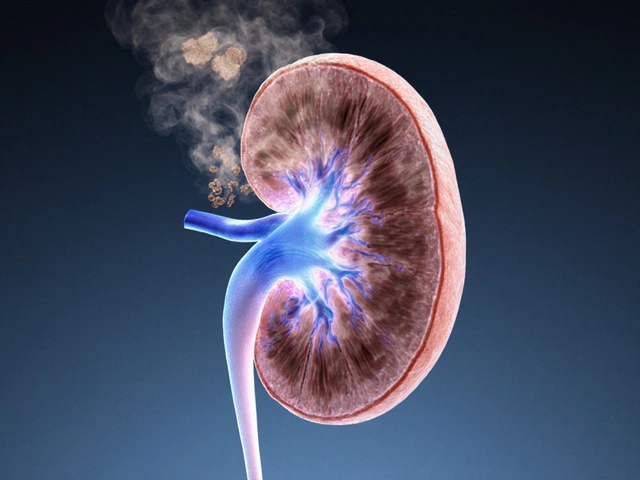Advanced RCC Treatment Regimen Selector
Patient Profile
Complete the following fields to determine the recommended treatment approach for advanced RCC.
Recommended Regimen
When kidney cancer spreads beyond the kidney, standard surgery alone isn’t enough. Targeted therapy is a class of drugs that home in on specific molecular pathways that drive tumor growth, giving clinicians a powerful way to slow or shrink advanced renal cell carcinoma (RCC). This article breaks down the major drug families, shows how they stack up against each other, and offers a practical checklist for choosing and managing the right regimen.
Why Targeted Therapy Matters for Advanced RCC
Advanced RCC is notorious for being resistant to conventional chemotherapy. The disease relies heavily on abnormal signaling through the vascular endothelial growth factor (VEGF) and the mammalian target of rapamycin (mTOR) pathways. By interrupting these signals, targeted agents turn a once‑dead‑end diagnosis into a chronic, controllable condition for many patients.
According to the 2024 NCCN guidelines, more than 70% of first‑line regimens for metastatic RCC now include a targeted drug, either alone or in combination with an immune checkpoint inhibitor. This shift has improved median overall survival from roughly 15 months (pre‑targeted era) to over 30 months for patients fit enough for combination therapy.
Major Classes of Targeted Agents
All approved targeted drugs for RCC fall into two broad families:
- VEGF inhibitors - small‑molecule tyrosine‑kinase inhibitors (TKIs) that block the VEGF receptors, cutting off the tumor’s blood supply.
- mTOR inhibitors - agents that disrupt the mTOR signaling hub, which controls cell growth and metabolism.
In the past five years, immune checkpoint inhibitors (PD‑1/PD‑L1 blockers) have been paired with VEGF TKIs, creating hybrid regimens that exploit both anti‑angiogenic and immunologic mechanisms.
Head‑to‑Head: Leading VEGF TKIs
| Drug | Primary Targets | Typical Dose | Median PFS (months) | Common Toxicities |
|---|---|---|---|---|
| Sunitinib | VEGFR‑1/2/3, PDGFR‑α/β | 50mg daily (4weeks on/2weeks off) | 11.0 | Fatigue, hand‑foot syndrome, hypertension |
| Pazopanib | VEGFR‑1/2/3, c‑Kit, PDGFR | 800mg daily | 10.5 | Liver enzyme elevation, nausea, hypertension |
| Axitinib | VEGFR‑1/2/3 | 5mg twice daily (adjustable) | 12.1 | Diarrhea, hypertension, proteinuria |
| Cabozantinib | VEGFR‑2, MET, AXL | 60mg daily | 14.3 | Palmar‑plantar erythrodysesthesia, hypertension, fatigue |
| Lenvatinib + Everolimus | VEGFR‑1/2/3, FGFR, PDGFR, RET (lenvatinib) + mTOR (everolimus) | 18mg lenvatinib + 5mg everolimus daily | 15.1 | Hypertension, diarrhea, fatigue |
These numbers reflect outcomes from pivotal phaseIII trials that led to FDA approval. Cabozantinib and the lenvatinib‑everolimus combo generally show the longest progression‑free survival (PFS), but they also bring higher rates of hand‑foot syndrome and hypertension, so patient‑specific factors matter.
Choosing the Right Regimen: Decision Framework
When you sit down with a patient, five variables usually drive the choice:
- Performance status - ECOG0‑1 patients can tolerate combination regimens; higher scores may limit you to single‑agent TKIs.
- Risk stratification - The International Metastatic RCC Database Consortium (IMDC) model categorizes patients into favorable, intermediate, or poor risk. Favorable‑risk disease often responds well to VEGF TKIs alone, while intermediate/poor risk benefits from VEGF+immunotherapy.
- Comorbidities - Pre‑existing hypertension, liver disease, or autoimmune disorders steer you away from certain agents.
- Biomarker profile - Although no definitive predictive marker exists, high PD‑L1 expression may tip the scale toward an immunotherapy‑centric approach.
- Patient preferences - Oral daily pills versus intravenous infusions, frequency of clinic visits, and tolerance for side‑effect trade‑offs all shape the final plan.
Putting these together yields a simple flow: Good performance+favorable risk→single‑agent VEGF TKI;
Good performance+intermediate/poor risk→VEGF TKI+PD‑1 inhibitor;
Poor performance→lower‑dose TKI or enrollment in a clinical trial.

Managing Toxicities and Resistance
Even the best‑tolerated TKI can cause dose‑limiting side effects. Here are three practical tips:
- Proactive blood‑pressure monitoring - Start antihypertensives before the first dose of cabozantinib or axitinib; aim for <140/90mmHg.
- Skin care for hand‑foot syndrome - Use urea‑based moisturizers, avoid friction, and reduce dose if Grade2 or higher appears.
- Liver‑function checks - Obtain baseline ALT/AST; hold therapy if enzymes exceed three times the upper limit of normal.
Resistance usually develops after 12‑18months. Switching to a different mechanism (e.g., from a VEGF TKI to an mTOR inhibitor) or adding an immune checkpoint inhibitor can recapture disease control in about half of those cases. Ongoing trials are testing triplet combos (VEGF+mTOR+PD‑1) to pre‑empt resistance.
Emerging Therapies and Clinical Trials (2025 Update)
Several novel agents are reshaping the landscape:
- HIF‑2α inhibitors - Belzutifan received accelerated approval for VHL‑associated RCC and is now being studied in sporadic advanced disease.
- Bispecific antibodies - Early‑phase data suggest that a VEGF‑PD‑L1 bispecific can achieve deep responses with fewer cycles of therapy.
- Adoptive cell therapy - Tumor‑infiltrating lymphocyte (TIL) infusions combined with TKIs are showing promise in refractory patients.
If you have an eligible patient, consider referral to a phaseII/III trial. The NCCN recommends that every patient with metastatic RCC be offered a trial option when standard options have been exhausted.
Practical Checklist for Clinicians
- Confirm histology (clear‑cell vs non‑clear‑cell) - most targeted agents are approved for clear‑cell RCC. \n
- Apply IMDC risk criteria before picking first‑line therapy.
- Baseline labs: CBC, CMP, fasting lipid panel, urine protein/creatinine ratio.
- Start antihypertensive prophylaxis for VEGF TKIs.
- Educate patients on signs of hand‑foot syndrome, liver toxicity, and severe fatigue.
- Schedule imaging (CT/MRI) every 8‑12weeks to assess response.
- Document side‑effects using CTCAE v5.0; adjust dose promptly.
- Re‑evaluate after 3months: consider switch to another class or add immunotherapy if progression observed.
Quick Takeaways
- Targeted therapy has become the cornerstone of advanced RCC management.
- VEGF TKIs (e.g., cabozantinib, axitinib) offer the longest PFS but require vigilant toxicity monitoring.
- Combination regimens with PD‑1 inhibitors boost overall survival for intermediate‑/poor‑risk patients.
- Resistance is inevitable; rotating mechanisms or enrolling in trials extends disease control.
- Use the IMDC model, performance status, and comorbidities to personalize therapy choice.
Frequently Asked Questions
Can targeted therapy cure advanced RCC?
Curative intent is rare for metastatic disease. Targeted agents aim to prolong survival, control symptoms, and sometimes shrink tumors enough for surgery or radiation. A small subset of patients achieve long‑term remission, especially when a combination of VEGF inhibition and immunotherapy is used early.
How do I decide between sunitinib and cabozantinib as first‑line therapy?
Cabozantinib generally offers longer PFS and works well for patients with bone metastases because it also hits MET and AXL pathways. However, it carries a higher risk of hand‑foot syndrome. If a patient has mild comorbidities and can tolerate more aggressive side‑effects, cabozantinib is a strong choice. For a patient who prefers a well‑established schedule and modest toxicity, sunitinib remains reasonable.
Are there any biomarkers that predict response to VEGF TKIs?
Currently, no single biomarker reliably predicts response. Some studies link high circulating VEGF levels to better TKI activity, but results are inconsistent. Research is ongoing on genomics (e.g., VHL mutations) and circulating tumor DNA, but clinicians still base decisions on clinical risk scores rather than molecular tests.
What should I do if a patient develops grade3 hypertension on axitinib?
First, optimize antihypertensive therapy (ACE‑inhibitor or calcium‑channel blocker). If blood pressure remains uncontrolled after 2weeks, hold axitinib for 1week, then resume at a reduced dose (e.g., 3mg twice daily). Persistent uncontrolled hypertension may require permanent discontinuation.
Is it safe to combine a VEGF TKI with pembrolizumab?
Yes, the pembrolizumab‑axitinib combination received FDA approval in 2022 and showed a median overall survival not reached at 30months. The key is close monitoring for immune‑related adverse events (colitis, hepatitis) and overlapping toxicities (fatigue, hypertension). Dose adjustments follow the same principles as TKI monotherapy, with added vigilance for autoimmune symptoms.







tabatha rohn
October 2, 2025 AT 16:05Honestly, if you’re still prescribing sunitinib as a first‑line monotherapy for a fit patient, you’re stuck in the stone age 😤. The data clearly favors combo regimens now.
Mark Rohde
October 7, 2025 AT 13:41Wow! This whole targeted therapy saga is just 🔥🔥🔥
Rajan Desai
October 12, 2025 AT 11:17The article correctly highlights VEGF and mTOR pathways as central to RCC pathogenesis. However, it omits recent data on HIF‑2α inhibitors, which are now FDA‑approved. Incorporating these agents could broaden the therapeutic algorithm. Moreover, biomarker‑driven patient selection remains an unresolved challenge. Future updates should address these gaps.
S O'Donnell
October 17, 2025 AT 08:53In the contemporary management of metastatic renal cell carcinoma, the therapeutic armamentarium has undergone a paradigm shift toward targeted modalities.
The author rightly emphasizes the significance of VEGF inhibition, yet fails to contextualize the pharmacokinetic nuances of each agent.
For instance, sunitinib’s intermittent dosing schedule often yields a cyclic pattern of toxicity that can be mitigated by dose escalation strategies.
Conversely, axitinib demands meticulous blood pressure surveillance due to its potent antihypertensive effects.
Cabozantinib, while offering superior progression‑free survival, is notorious for inducing hand‑foot syndrome, a condition that necessitates dose reductions in a substantial proportion of patients.
The combination of lenvatinib and everolimus, though efficacious, imposes a dual burden of hypertension and metabolic disturbances.
It is also imperative to recognize the role of immunotherapy, particularly PD‑1 inhibitors, as they synergize with VEGF TKIs to potentiate anti‑tumor immunity.
The author’s decision framework could benefit from integrating the International Metastatic RCC Database Consortium risk scores more explicitly.
Patients classified as favorable risk may derive comparable benefit from monotherapy, obviating the need for combination‑related adverse events.
Conversely, intermediate and poor‑risk cohorts typically exhibit improved overall survival when exposed to VEGF‑TKI plus checkpoint blockade.
Comorbid conditions such as uncontrolled hypertension or hepatic insufficiency must guide the selection of agents with more favorable safety profiles.
Moreover, the emerging data on HIF‑2α antagonists, such as belzutifan, suggest a novel therapeutic avenue that warrants inclusion in future guidelines.
Clinical trial enrollment remains a cornerstone for patients with poor performance status, offering access to investigational compounds.
Finally, proactive management of side effects through multidisciplinary support can markedly enhance treatment adherence.
In summary, while the article provides a solid overview, a more granular discussion of dosing nuances, emerging agents, and risk‑adapted strategies would greatly augment its clinical utility.
Yamunanagar Hulchul
October 22, 2025 AT 06:29Wow!!! 🎉 What a comprehensive deep‑dive, truly enlightening! Your thoroughness shines like a beacon for us clinicians-keep it up!!! 🌟
Sangeeta Birdi
October 27, 2025 AT 03:05I hear you-balancing efficacy and side‑effects can feel overwhelming 😔. Remember, you’re not alone in navigating these choices.
Chelsea Caterer
November 1, 2025 AT 00:41Patients need options, doctors need data.
Lauren Carlton
November 5, 2025 AT 22:17While the overview is useful, the article misspells “progression‑free” as “progression‑free”. Proper hyphenation is essential for clarity.
Katelyn Johnson
November 10, 2025 AT 19:53Great points everyone let’s keep sharing resources and experiences together
Elaine Curry
November 15, 2025 AT 17:29Honestly i think you all are missing the real story patients want a simple pill not all this hassle
Patrick Fortunato
November 20, 2025 AT 15:05In my view American trials set the gold standard-nothing beats the data coming out of US research.